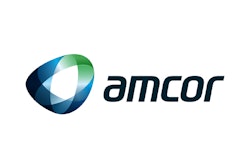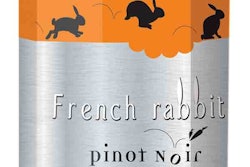
The words "French wine maker" typically conjure up images of long-standing tradition: a picturesque chateau, rows of oak barrels in a dimly lit and stone-floored cellar, the sound of a cork popping from a green glass bottle.
But these are not the images associated with Boisset Vins & Spiritueux, a 46-year-old winery in the heart of France’s famous Burgundy region. Instead, try plastic screw caps, shatterproof containers, and temperature-sensing labels.
Boisset’s latest innovation is its launch of Yellow Jersey, a line of fine wines in a 750-mL PET bottle weighing just 51 g. Designed and stretch blow molded by MPI Packaging (www.mpi-pkg.com), the bottle’s preforms are injection molded by Constar International (www.constar.net). Constar includes its proprietary MonOxbar™ active oxygen scavenger material in producing the monolayer preforms, and it is this component that protects Boisset’s merlot, pinot noir, chardonnay, and sauvignon blanc varietals from oxidation. These wines, of course, aren’t meant to be stored for years in a cellar. They are for consumption within about a year of purchase.
Like Boisset’s 2005 launch of French Rabbit in a 1-L Tetra Pak (www.tetrapak.com) container (see sidebar), the development of the Yellow Jersey package was driven to a large extent by environmental concerns. Both French Rabbit and Yellow Jersey appeared first in the stores run by Canada’s Liquor Control Board of Ontario, the provincial corporation established in 1927 to sell alcohol in Ontario through a chain of retail stores. That organization views glass alternatives such as Tetra Pak, PET, and aluminum containers as highly desirable, from an environmental standpoint, compared to glass. These glass alternatives, says the LCBO, "reduce package weight by more than 90% compared to glass bottles. Due to their lightweight format, they also reduce energy consumption and greenhouse gas emissions during transport."
"This new packaging was chosen for reasons of sustainability and performance," says Jean-Charles Boisset, president of the Boisset winery. "We needed a package that would protect our premium wines. A key driver was our desire to satisfy the LCBO’s environmental initiative, which aims to educate brand owners to consider more sustainable packaging materials. Both the company and I have a firm commitment to environmental preservation."
Also notable about the Yellow Jersey bottle are the screw cap closure, supplied by the Stelvin division of Alcan Group (www.alcanpackaging.com), and the embossed pattern of tiny jerseys molded into the bottle sidewalls. The yellow jersey, of course, has long been used in the Tour de France to identify the leading bicyclist. Boisset’s use of it identifies the winery as a leader in packaging innovation, says Jean-Charles Boisset.
So why bring out the dramatically innovative Yellow Jersey bottle when the French Rabbit in its Tetra Pak format already accomplishes so many of the same environmental goals?
Options matter
"Because consumers want options," says Jean-Charles Boisset. "The world of wine going forward is about diversity and choice. Consumption will occur at the beach, a party, a fine dining establishment, or a concert. Each of these has its own peculiarities. Why not have a variety of packaging formats so that you can appeal to each of those peculiarities?"
Jean-Charles acknowledges that some consumers just don’t want to have wine from a container that isn’t shaped like a bottle. It’s another reason he’s pleased to have a PET bottle in his portfolio.
"However," he points out, "until the MonOxbar became available, we didn’t have a viable option in plastic. Now we have an oxygen-scavenging layer that brings the performance characteristics we need."
While Ontario served as the launch pad for Yellow Jersey, Boisset plans to bring it to the U.S. soon. Filling is done by a contract packager in Ontario, though the wine is sent from France in 24,000-L containers. Selling price in Ontario is $14.95 Canadian.
Aluminum’s on deck
As if French Rabbit and Yellow Jersey weren’t innovation enough, Boisset’s next "first" in the world of wine will be an aluminum container (right).
"Beaujolais and Macon Villages are best served chilled to about 44 degrees F," Boisset explains. "So why not provide those wines to the consumer or the restaurant owner in the container that is best for chilling quickly and staying chilled longer? Besides, like the Tetra Pak and the PET bottle, aluminum is recyclable, it occupies far less volume in the landfill should it not get recycled, and it weighs much less during transport. All three of our alternatives to glass offer the same environmental advantages."
One intriguing feature on the aluminum bottle is what Boisset calls the Chill Dot. "At 44 degrees F, the proper temperature for serving a Macon Villages or a Beaujolais, the dot turns from white to blue," says Boisset. "It tells the consumer when the wine is properly chilled."
Neither the bottle maker nor the label supplier are identified by Boisset. At Boisset’s Mommessin winery in France, bottles are labeled, filled, and capped. Filling and capping required some customization, since the aluminum bottle can’t withstand the top-load pressure that glass can. But otherwise, says Boisset, the aluminum container handles pretty much like glass or plastic on the filling line.
Boisset is clearly excited at the prospect of launching the aluminum container some time this summer. But he remains every bit as enthusiastic about his other two alternative formats.
"With Tetra Pak, with PET, and now with aluminum, we wanted to be among the first," says Boisset. "With our reputation as a great French wine maker, we were in the perfect position to push the limits this way with packaging. Don’t get me wrong, glass and cork are perfect if you want to keep wine for five or 10 years. But when so many wines are consumed in a matter of days after they’re purchased, why not use these new formats?"
Why not indeed?

























